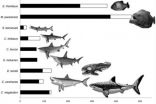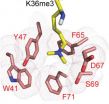(Press-News.org) AMHERST, Mass. – Contributing geometric and topological analyses of micro-materials, University of Massachusetts Amherst mathematician Robert Kusner aided experimental physicists at the University of Colorado (UC) by successfully explaining the observed "beautiful and complex patterns revealed" in three-dimensional liquid crystal experiments. The work is expected to lead to creation of new materials that can be actively controlled.
Kusner is a geometer, an expert in the analysis of variational problems in low-dimensional geometry and topology, which concerns properties preserved under continuous deformation such as stretching and bending. His work over 3 decades has focused on the geometry and topology of curves, surfaces and other spaces that arise in nature, such as soap films, knots and the shapes of fluid droplets. Kusner agrees with physicist and lead author Ivan Smalyukh of UC Boulder that their collaboration is the first to show in experiments that some of the most fundamental topological theorems hold up in real materials. Their findings appear in the current early online issue of Nature.
UMass Amherst's Kusner explains, "There are two important aspects of this work. First, the experimental work by the Colorado team, who fabricated topologically complex micro-materials allowing controlled experiments of three-dimensional liquid crystals. Second, the theoretical work performed by us mathematicians and theoretical physicists while visiting the University of California Santa Barbara's Kavli Institute for Theoretical Physics (KITP). We provided the geometric and topological analysis of these experiments, to explain the observed patterns and predict what patterns should be seen when experimental conditions are changed."
Kusner was the lone mathematician among four organizers of last summer's workshop on "Knotted Fields" at KITP, which led to this work. The workshop engaged about a dozen other mathematicians and about twice as many theoretical and experimental physicists in a month-long investigation of the interplay between low-dimensional topology and what physicists call "soft matter."
In their experiments, the physicists at UC Boulder showed that tiny topological particles injected into a liquid crystal medium behave in a manner consistent with established theorems in geometry and topology, Kusner says. The researchers say they have thus identified approaches for building new materials using topology.
UC Boulder's Smalyukh and colleagues set up the experiment by first creating colloids, solutions in which tiny particles are dispersed but not dissolved in a host medium, such as milk, paint and shaving cream. Specifically, they injected tiny, different-shaped particles into a liquid crystal, which behaves something like a liquid and a solid. Once injected into a liquid crystal, the particles behaved as predicted by topology.
Smalyukh says, "Our study shows that interaction between particles and molecular alignment in liquid crystals follows the predictions of topological theorems, making it possible to use these theorems in designing new composite materials with unique properties that cannot be encountered in nature or synthesized by chemists. These findings lay the groundwork for new applications in experimental studies of low-dimensional topology, with important potential ramifications for many branches of science and technology."
For example, he adds, these topological liquid crystal colloids could be used to upgrade current liquid crystal displays like those used in laptops and television screens, to allow them to interact with light in new, more energy efficient ways.
INFORMATION:
Besides Kusner at UMass Amherst and Smalyukh's group at UC Boulder, other investigators for this study are Sailing He of Zhejiang University, China and Randall Kamien and Tom Lubensky at the University of Pennsylvania.
Liquid crystal research, future applications advance
Mathematics explains the observed 'beautiful and complex patterns revealed' in three-dimensional liquid crystal experiments, expected to lead to creation of new materials that can be actively controlled.
2012-12-27
ELSE PRESS RELEASES FROM THIS DATE:
Benefits of higher oxygen, breathing device persist after infancy
2012-12-27
By the time they reached toddlerhood, very preterm infants originally treated with higher oxygen levels continued to show benefits when compared to a group treated with lower oxygen levels, according to a follow-up study by a research network of the National Institutes of Health that confirms earlier network findings. Moreover, infants treated with a respiratory therapy commonly prescribed for adults with obstructive sleep apnea fared as well as those who received the traditional therapy for infant respiratory difficulties, the new study found.
In the original 2010 ...
Development of new corneal cell line provides powerful tool
2012-12-27
Human corneal endothelial cells (HCEnCs) form a monolayer of hexagonal cells whose main function is to maintain corneal clarity by regulating corneal hydration. Cell loss due to aging or corneal endothelial disorders, such as Fuchs dystrophy, can lead to cornea edema and blindness, resulting in the need for cornea transplants.
Studying human corneal endothelium has been difficult for cell biologists because limited cellular model systems exist and have significant drawbacks. The major drawback is that HCEnC cells do not divide and there is a limited source of these cells ...
New technique catalogs lymphoma-linked genetic variations
2012-12-27
As anyone familiar with the X-Men knows, mutants can be either very good or very bad — or somewhere in between. The same appears true within cancer cells, which may harbor hundreds of mutations that set them apart from other cells in the body; the scientific challenge has been to figure out which mutations are culprits and which are innocent bystanders. Now, researchers at Johns Hopkins Medicine have devised a novel approach to sorting them out: they generated random mutations in a gene associated with lymphoma, tested the proteins produced by the genes to see how they ...
Ability to metabolize tamoxifen affects breast cancer outcomes, Mayo Clinic-led study confirms
2012-12-27
ROCHESTER, Minn. -- For nearly a decade, breast cancer researchers studying the hormone therapy tamoxifen have been divided as to whether genetic differences in a liver enzyme affect the drug's effectiveness and the likelihood breast cancer will recur. A new study by researchers from the Mayo Clinic Cancer Center and the Austrian Breast and Colorectal Cancer Study Group provides evidence that genetic differences in the enzyme CYP2D6 play a key role in how well tamoxifen works.
"Our findings confirm that, in early breast cancer treated with tamoxifen, genetic alterations ...
Immune system changes may drive aggressiveness of recurrent tumors
2012-12-27
PHILADELPHIA – Nearly half of the 700,000 cancer patients who undergo surgical removal of a primary tumor each year suffer a recurrence of their disease at some point, and many of those patients will eventually die from their disease. The traditional view of recurrent tumors is that they are resistant to therapy because they've acquired additional genetic mutations that make them more aggressive and impervious to drugs. Now, however, researchers at the Perelman School of Medicine at the University of Pennsylvania show in an animal model that the enhanced aggressiveness ...
Piranha kin wielded dental weaponry even T. rex would have admired
2012-12-27
Taking into consideration its size, an ancient relative of piranhas weighing about 20 pounds delivered a bite with a force more fierce than prehistoric whale-eating sharks, the four-ton ocean-dwelling Dunkleosteus terrelli and – even – Tyrannosaurus rex.
Besides the force of the bite, Megapiranha paranensis appears to have had teeth capable of shearing through soft tissue the way today's piranhas do, while also being able to pierce thick shells and crack armoring and bones, according to Stephanie Crofts, a University of Washington doctoral student in biology.
"If our ...
Doctors call for evidence-based appropriateness criteria for elective procedures
2012-12-27
Many of the most common inpatient surgeries in the United States are performed electively. These surgeries are expected to significantly increase with the enactment of the Affordable Care Act. In a new perspectives article, published in the Dec. 27 edition of The New England Journal of Medicine, a team of Weill Cornell Medical College researchers are recommending the nation's health care leaders and medical community join forces to establish evidence-based appropriateness criteria to determine which patients are most in need of elective procedures, such as joint replacement ...
UNC research uncovers new insight into cell development and cancer
2012-12-27
CHAPEL HILL - Long-standing research efforts have been focused on understanding how stem cells, cells capable of transforming into any type of cell in the body, are capable of being programmed down a defined path to contribute to the development of a specific organ like a heart, lung, or kidney. Research from the University of North Carolina at Chapel Hill School of Medicine has shed new light on how epigenetic signals may function together to determine the ultimate fate of a stem cell.
The study, published December 27, 2012 by the journal Molecular Cell, implicates ...
Genetic sequencing breakthrough to aid treatment for congenital hyperinsulinism
2012-12-27
Congenital hyperinsulinism is a genetic condition where a baby's pancreas secretes too much insulin. It affects approximately one in 50,000 live births and in severe cases requires the surgical removal of all or part of the pancreas.
Researchers at the University of Exeter Medical School are the first in the world to utilise new genetic sequencing technology to sequence the entirety of a gene in order to identify mutations that cause hyperinsulinism. Previously, existing technology limited such sequencing to only part of the coding regions of the gene which meant that ...
Cellular fuel gauge may hold the key to restricting cancer growth
2012-12-27
Researchers at McGill University have discovered that a key regulator of energy metabolism in cancer cells known as the AMP-activated protein kinase (AMPK) may play a crucial role in restricting cancer cell growth. AMPK acts as a "fuel gauge" in cells; AMPK is turned on when it senses changes in energy levels, and helps to change metabolism when energy levels are low, such as during exercise or when fasting. The researchers found that AMPK also regulates cancer cell metabolism and can restrict cancer cell growth.
The discovery was made by Russell (Rusty) Jones, an assistant ...
LAST 30 PRESS RELEASES:
Scalable and healable gradient textiles for multi‑scenario radiative cooling via bicomponent blow spinning
Research shows informed traders never let a good climate crisis go to waste
Intelligent XGBoost framework enhances asphalt pavement skid resistance assessment
Dual-function biomaterials for postoperative osteosarcoma: Tumor suppression and bone regeneration
New framework reveals where transport emissions concentrate in Singapore
NTP-enhanced lattice oxygen activation in Ce-Co catalysts for low-temperature soot combustion
Synergistic interface engineering in Cu-Zn-Ce catalysts for efficient CO2 hydrogenation to methanol
COVID-19 leaves a lasting mark on the human brain
Scientists use ultrasound to soften and treat cancer tumors without damaging healthy tissue
Community swimming program for Black youth boosts skills, sense of belonging, study finds
Specific depressive symptoms in midlife linked to increased dementia risk
An ‘illuminating’ design sheds light on cholesterol
Who is more likely to get long COVID?
Study showcases resilience and rapid growth of “living rocks”
Naval Research Lab diver earns Office of Naval Research 2025 Sailor of the Year
New Mayo-led study establishes practical definition for rapidly progressive dementia
Fossil fuel industry’s “climate false solutions” reinforce its power and aggravate environmental injustice
Researchers reveal bias in a widely used measure of algorithm performance
Alcohol causes cancer. A study from IOCB Prague confirms damage to DNA and shows how cells defend against it
Hidden viruses in wastewater treatment may shape public health risks, study finds
Unlock the power of nature: how biomass can transform climate mitigation
Biochar reshapes hidden soil microbes that capture carbon dioxide in farmland
Reducing saturated fat intake shows mortality benefit, but only in high-risk individuals
Manta rays create mobile ecosystems, study finds
Study: Mixed results in using lipoic acid to treat progressive multiple sclerosis
Norbert Holtkamp appointed director of Fermi National Accelerator Laboratory
New agentic AI platform accelerates advanced optics design
Biologists discover neurons use physical signals — not electricity — to stabilize communication
Researchers discover that a hormone can access the brain by hitchhiking
University of Oklahoma researcher awarded funding to pursue AI-powered material design
[Press-News.org] Liquid crystal research, future applications advanceMathematics explains the observed 'beautiful and complex patterns revealed' in three-dimensional liquid crystal experiments, expected to lead to creation of new materials that can be actively controlled.


